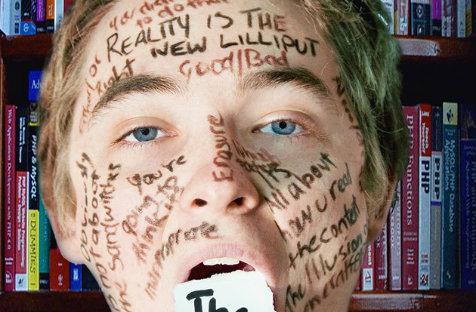Presented by RePlay Theatre, a new company dedicated to remounting Australian works, The Joy of Text is a deliciously ambitious play centred around the adolescent Danny (Colin Craig), a bright young student who deliberately plagiarises a Wikipedia article on Jonathan Swift for an English assignment on ‘satire’. His teacher (Kasia Kaczmarek) disapproves, and unintentionally embarrasses him in front of the class. In order to get revenge, Danny sets about re-enacting The Illusion of Consent, a notorious book written by a teenage girl about her affair with her art teacher, which later turned out to be a hoax and is now under consideration for the VCE syllabus.
Following its Melbourne Theatre Company premiere in 2011, playwright Robert Reid has further revised The Joy of Text for this new production directed by Peita Collard. The result is a play acutely self-aware of its multilayered structure. The surface narrative examines the contemporary issues around the duty of care owed by teachers to students, the dynamics in a school environment, and of course the taboo subject of student-teacher relationships. But Reid delves deeper, examining the way society’s laws and moral codes affect our own interpretation of any literary text in the 21st century.
Collard’s direction and the capable cast soften what could have been a bombardment of Big Ideas in Reid’s complex script. Elizabeth Thomson excels as the uptight and haughty teacher Diane, but also appears wise, even manipulative, when needed. Kaczmarek stumbles at times, but still delivers the nuances and complexities required when her character is accused of inappropriate behaviour. Jason Cavanagh plays the anxious, bumbling Acting Principal, offering some light comic relief, while Craig’s Danny aptly navigates a character who is equal parts academic intellect and teenage naivety.
It is an arduous task to follow Reid’s lavish script, but set and lighting designer Rob Sowinski boldly endeavours to do so. The stage floor is made up of a collage of worksheets and book covers that neatly becomes a prop at one point. However, it is the play’s use of technology that displays true signs of creativity.
Two televisions flank the stage and a large screen is positioned as a backdrop. The two televisions display literary definitions, author biographies and even samples of the play’s dialogue throughout the show. It becomes a pronounced statement on the abundance of information afflicting modern society, or the problems in defining language. Despite its ingenuity, this high level of information can become overwhelming, just like the problem it aims to comment on. These set elements also become props – one of the televisions is used for a scene involving a faulty DVD player in the school laboratory.
Thanks to film designer Isaac Mitchell-Frey, the large screen at the rear of the stage displays well-framed scenes that serve as background noise and scenarios for the cast to interact with. Thomson gives directions to students at a stage rehearsal while Kaczmarek begrudgingly returns a basketball to students playing in the courtyard.
In one particular scene, Danny grabs a portable video camera to practice for an oral presentation, only to use it on members of the audience. He pans across our faces; the resulting blank expressions and smirking faces appear on the giant screen behind him. It is an interesting turn; for just one moment, the audience is unknowingly and unwillingly in the spotlight.
With all these different mediums for the cast to play with, it begs the question: is the medium really the message here? Collard’s production is undoubtedly clever, and a unique take on the use of a stage and an audience in theatre. At the same time, as with every postmodernist struggle, it comes uncomfortably close to being gimmicky or self-indulgent.
In the end, one can’t help but wonder if The Joy of Text is a self-conscious and ironic attempt at becoming its own satirical case study. It fumbles through comedy and serious issues, and its maximalist approach ultimately ensures the production becomes a victim of its own success. Nevertheless, The Joy of Text still determinedly pulls through the chaos and clutter of ideas. It’s hard to dismiss the play’s earnest efforts in exploring a vast assortment of issues concerning language, theatre, and society.
Rating: 3 stars out of 5
The Joy of Text
By Robert Reid
Director: Peita Collard
Producer: Rikki Lee Butinar
Set and lighting designer: Rob Sowinski
Film designer: Isaac Mitchell-Frey
Sound designer: Kiernan Box
Cast: Jason Cavanagh, Colin Craig, Kasia Kaczmarek and Elizabeth Thomson
La Mama Courthouse, Melbourne
7 – 24 March





